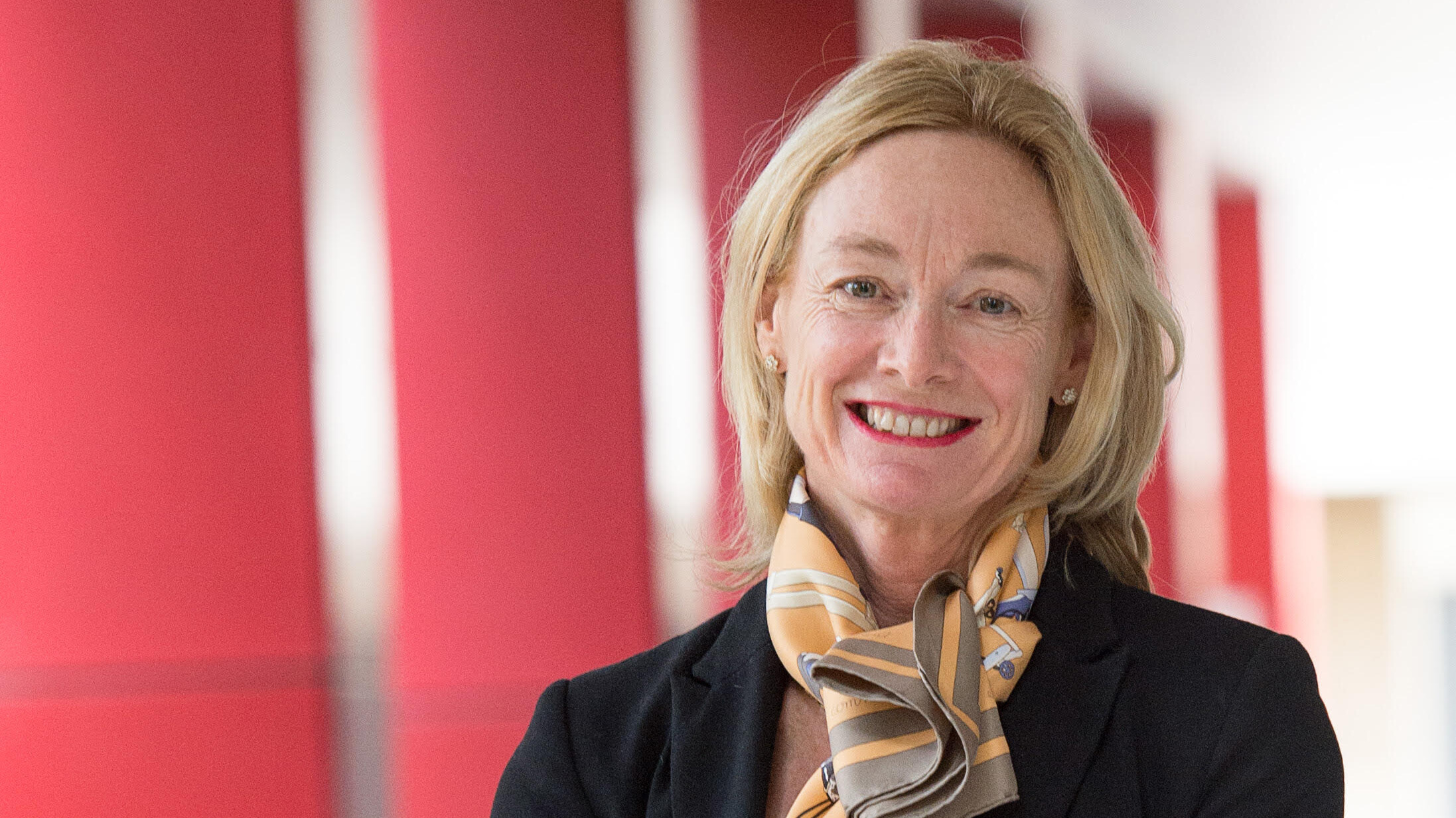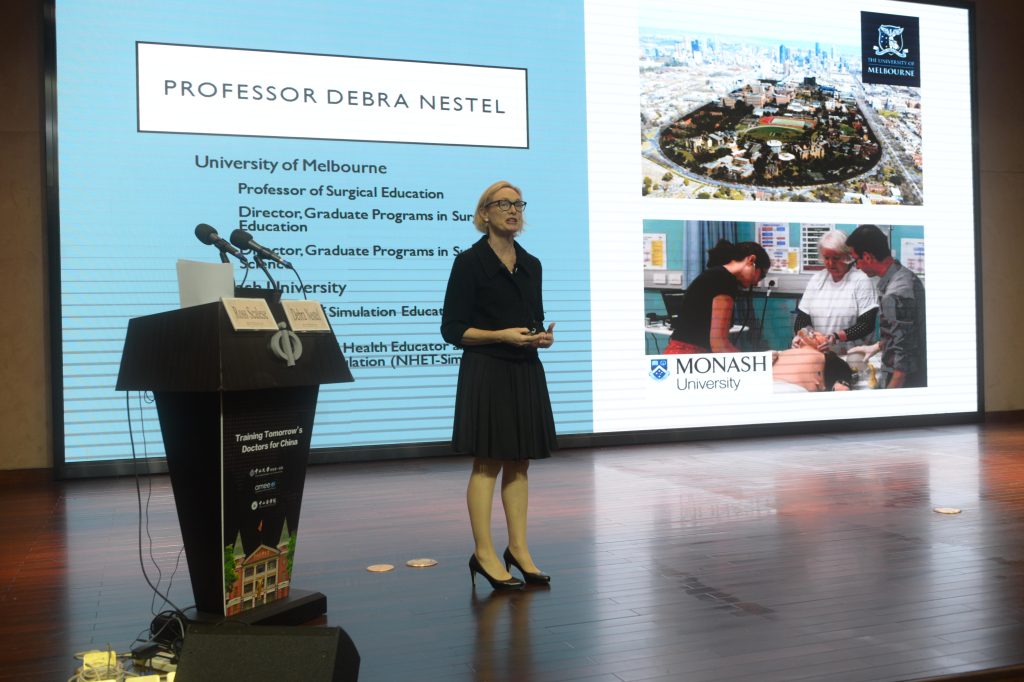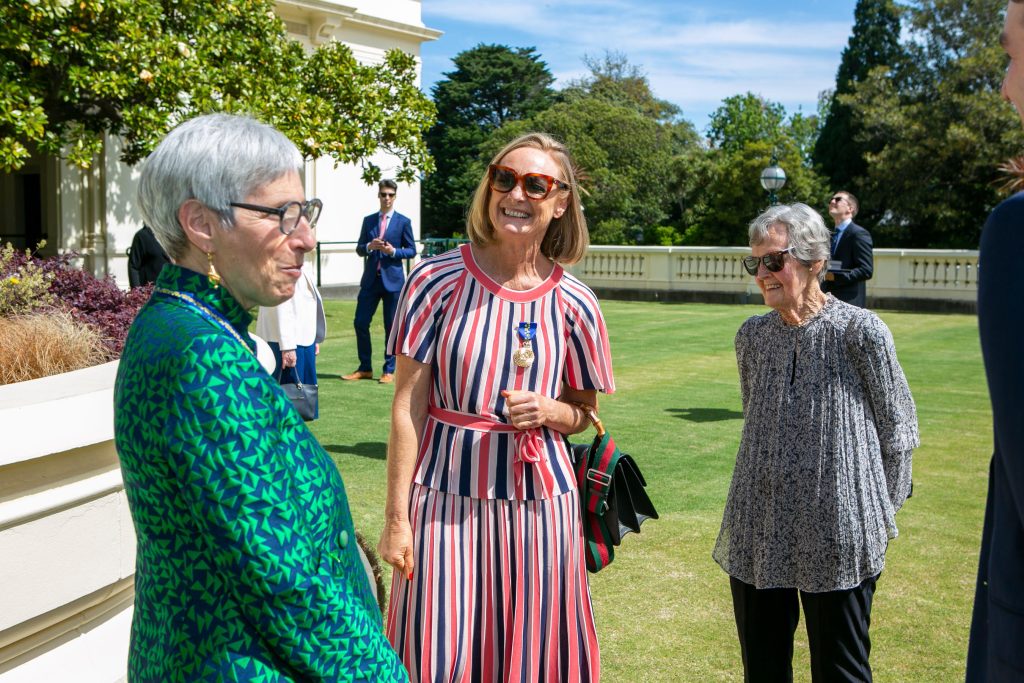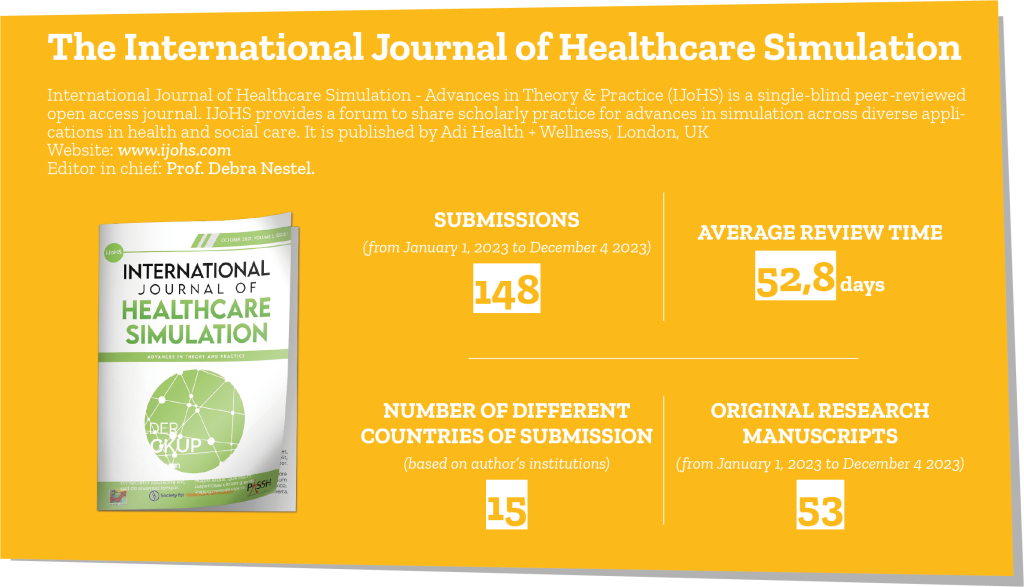Debra Nestel, the Editor-in-Chief of the International Journal of Simulation in Healthcare (IJoHS), provides a candid look at her leadership in this insightful interview. With an academic journey, spanning Hong Kong, London, and Melbourne, she discusses her pivotal role in IJoHS and touches on the journal’s identity, challenges, and short- and long-term goals. Debra also underscores the journal’s commitment to diversity, equity, and inclusion, and provides valuable advice for those aspiring to become EiC in simulation journals.
Debra Nestel’s multifaceted career and influential roles in academia make her a prominent figure in healthcare simulation and education. Her academic journey has touched different locations, such as Hong Kong, London, and Melbourne, highlighting her diverse experiences and her natural capacity to make collaborations and connections. It is surprising how much attention Debra pays to the use of words which, with good reason, are a powerful tool for simulationists. She has been editorial director of two simulation journals and is now at the helm of IJoHS.
Debra Nestel

Professor of Simulation Education in Healthcare, Monash University, and Professor of Surgical Education, Department of Surgery, University of Melbourne, Australia.
Program lead for the Graduate Programs in Clinical Simulation (Monash University) and the Graduate Programs in Surgical Education (University of Melbourne).
Lead of the national faculty development program for simulation practitioners – NHET-Sim.
Hi Debra, thank you very much for joining this initiative which aims to present a behind-the-scenes look at the journal you lead and provide insights into the editor-in-chief’s perspective. Can you describe your role? What do you do day-to-day?
Thanks for the opportunity to talk with you. As a new researcher, I always wondered what went on behind-the-scenes at journals, so it is interesting (and a privilege) to occupy that space. As EIC, my role is to take ultimate responsibility for the decisions about manuscripts that come into our portal. To do this, I need a reliable manuscript management system, a stellar editorial board and a diligent journal management team. While my core responsibilities are confined to decisions about manuscripts, there is a lot of checking and re-checking, of engaging with editorial board members and reviewers and of course the production team. It’s far too easy for manuscripts to linger too long in the system so keeping track of the review process is important. Editorial board members are all busy and so I empathize with the challenges of fitting this into already full professional lives. I probably check the system every couple of days rather than every day. Of course, the manuscript management software is automated, so I get reminders to log in! It is a lot of work on top of my “day job”. With our current volume of manuscripts in the system it probably takes me up to two full days a week, but I usually distribute that over several days. Almost everything is done online. My most frequent contact is with our NewGen managing director, Jo Bottrill, and then it is with the Senior Editorial team. As an international journal we schedule meetings at different times of the day – very early for some and very late for others – so we can catch all time zones. We never expect all editorial board members to be present: they attend the meeting that is scheduled for a relatively civilized time. Editorial governance in the journal is important to ensure we meet standards expected on academic journals. That is the hardest and most demanding part but it is rewarding when I receive notification from satisfied readers, authors, reviewers and board members.
What is your favorite part of the job? And what elements of your job do you think some people could dislike?
My favourite part of the job is receiving new submissions. Of course, I also enjoy communicating “accept” decisions on manuscripts but I think the new submissions are the most exciting part. I just never know what to expect. As for the dislike… finding reviewers who can do a “true” peer review can be really challenging, especially if the focus of a manuscript is a little outside my own expertise. The editorial board has wide ranging expertise so I may have to ask for assistance. It’s not that I dislike asking so much as taking up my colleagues’ time. If I had more knowledge on that area then I would not have had to ask them. I mainly enjoy the role so it’s hard to think of anything about the generic role that I dislike.
Can you give us an overview of your academic career and how you got to where you are today?
I studied at Monash University for my first degree, in sociology. I then moved to Hong Kong where I worked in the medical school at the University of Hong Kong (HKU) as a ‘demonstrator’ in medical sociology. I had some excellent mentoring at HKU with Dr Carol Betson and Prof Richard Fielding. HKU is where I did my first simulation work, with a simulated patient program for teaching and learning patient-centred communication. That was in 1980! I had three babies in HK and then moved to London where I started working as a Lecturer in Communication Skills at Imperial College. Again, some terrific colleagues. I worked closely with Prof Jane Kidd and Prof Roger Kneebone. When you find colleagues that you love working with then it means pretty much everything. Work becomes such good fun even with all the pressures that are often experienced by academics in universities. I stayed at Imperial for about 12 years with a short break in the middle to return to Melbourne. I’ve been back in Melbourne for about 15 years and have a split appointment between the University of Melbourne (surgical education) and Monash University (clinical simulation). I’ve been involved in faculty development for clinical education (as teaching and research) and for simulation seemingly forever. I really love seeing people develop.
What is your workspace like? Are you ever working from home?
Since COVID-19, I mainly work from home or wherever I happen to be! Most of my faculty development courses are online so I can be anywhere.

Can you describe the International Journal of Simulation in Healthcare? We would like to hear how its EiC sees it.
I think IJoHS publishes really interesting content relevant to individuals using simulation as an educational method, for systems testing or as a test bed itself or for developing simulators or simulations. We love to receive ideas that challenge current practices. We’ve a range of different article types which encourages some critical thinking and ideas generation. For example, we publish essays. We also publish research protocols so your research design can be peer reviewed before you get started. Two of our editors, Drs Asit Misra and Rami Ahmed, do a magnificent job leading the innovations supplement (SRSIS). This supplement is published twice annually and is a collection of short publications on really good ideas in simulation. The ideas may not have been conceived of as research but have turned out in practice to work well. At times it might seem as though IJoHS is being all things to all people! However, I think we need some focus but at this nascent stage of development, the journal is developing its own identity. I am loving the strong qualitative, exploratory and inclusive culture the content currently reflects.
What are the short- and long-term goals of your work with the journal you’re leading?
Quality is central to IJoHS content. Specific short-term goals are mainly focused on a really positive user experience: whatever engagement you have with IJoHS, I want to be a very positive one. Whether it be as a reader, reviewer, author, or editor, I want people to be left with a positive experience. Longer-term goals focus on wider indexing of the journal and remaining deeply connected to the needs of the healthcare simulation community.
What advice would you offer to researchers in order to get their article published in your journal?
There are some fundamental considerations:
- Read the author guidelines.
- Make sure you have explored the literature before submitting (and have done so recently!).
- Position your research in what is already known (or not known) so that you demonstrate that you are building on or challenging or filling a gap or addressing a problem that is of interest – beyond your workplace.
- Use theory coherently through your manuscript.
- Submit a polished manuscript – grammar checked; spell checked; references consistent etc. – so that your reviewers welcome the read and are not distracted by substandard academic presentation.
- Write a persuasive letter to the editor to ensure that the manuscript goes for peer review. By this I mean be clear about why the manuscript is important.
Thank you very much, Debra, for these concrete recommendations. We will take them as a starting point, perhaps, to write a quick guide for new authors. Nowadays, which is the most frequent reason the articles submitted are rejected?
The most frequent reason is that the manuscript does not add anything to what is already known.
The quality of the peer review process is critical to the journal’s development and success in terms of visibility and reputation. How do you select your reviewers?
I talk about “true” peer review by which I mean someone who has expertise on the specific topic or research method or simulation approach. They do not have to have all that expertise but at least part of it and stick to their expertise. It doesn’t mean that just because someone works in simulation they can review any manuscript. As editors are inviting reviewers, I encourage them to make a personal note acknowledging the reviewers’ expertise and that the reviewer can confine their review to a component of the manuscript. As a qualitative researcher, for years I experienced reviews from people without that expertise and it was super frustrating – a driver to becoming more involved in publishing. We rely on the wide networks of our editorial board to recruit reviewers. While we sometimes make invitations to “cold call” reviewers, generated through our manuscript review software, we mainly work with reviewers known to our extended networks.
Which words would you like to ban from IJoHS? An editor has to ban words!
Thanks for asking this question. There are a few words that I think require critical reflection and I’ve certainly made that known. Our language is evolving. Just because the words have been used for some time, it doesn’t mean we should retain them. Any words that are framed as “non” need consideration . “Non” usually implies that what follows is missing something, is in deficit. Non-clinician is commonly used. I’d just invite our community to think about the messages that is sending. I’ve written many times about “non-technical skills”. Some of the so-called “non-technical skills” are indeed technical. Anyone who wants to follow this up might like to read these 3 articles: Nestel D, et al (2011), Murphy P, et al. (2019) and Murphy P & Nestel D (2022)
In the references above, I also refer to the use of the term “standardized patient”. I just do not think there is ever a reason to use the word “standardized” in front of the word “patient”. Instead, I prefer the phrase – simulated patient (or participant) and if standardization is important (e.g. for examinations) then I refer to standardized portrayal. While it may seem a nuanced difference, the former sends important messages about objectification of patients. See Nestel D, et al. (2021). I’m not that interested in banning words. However, I think authors need to justify the use of all their words, especially those that may be unhelpful and inaccurate. I have noticed “confederate” has been removed from the SSH Dictionary. This is not a word that I have strong feelings about and as an EIC of an international journal, I need to be sensitive to the impact on some readers. I respect this recommendation.

Very few people can say they have fulfilled the role of EiC. If I am right, you have already led 2 journals and IJoHS is your third. Why did you want to become an EiC of simulation journals?
Being foundation editor at Advances in Simulation (AiS)was an immense honour. I think I left the journal in great shape and perhaps my proudest moment was the achievement of the PubMed indexing during my tenure. Even one substandard manuscript slipping through the peer review process is enough to scupper a positive outcome. Advances in Simulation and Simulation in Healthcare are the only two healthcare simulation journals with such indexing. BMJ STEL did not achieve PubMed indexing, it had a failed attempt prior to my arrival. I was very disappointed that for other reasons that journal was closed. Academic publishing is a highly competitive market. While I was excited to start another journal, it has been challenging! We’re established enough to commence Article Processing Charges (APC). I anticipate this will slow the submissions which have been hard to keep up with. Our production colleagues are highly professional and experienced and we are a small ‘publishing house’ which enables us to be more flexible than some of the bigger publishers. As to why I wanted to become an editor, I like the excitement of being at the forefront of amazing ideas – not my own – those of authors and the editorial board! I’ve had some bad experiences trying to get published and I don’t want that to be the experience of our authors. Manuscript rejection can still be positive and productive.
A recent published paper analyzed the Diversity, Equity, and Inclusion on Editorial Boards of Global Health Journals and calls for swift actions. What are you doing at your journal in terms of DEI?
Thanks for flagging this. I have prioritized Diversity, Equity and Inclusion (DEI) on Editorial Boards as an issue for several years, starting with my time at AiS. For the editorial board at AiS, I wanted diversity not only in terms of gender but also geographical location of the workplace. Further, I wanted board diversity in terms of professional background and simulation modality experience. I regularly compared our achievements against the published information of other healthcare simulation journals and while we looked quite shiny, there was still work to be done to fully engage rather than just have names on our website. I gave a lecture on this sometime ago in an online SESAM Lou Oberndorf Lecture – Superiority, Bias and Scholarship in Healthcare Simulation. I was appointed to the role at BMJ STEL on a commitment to DEI, starting with the editorial board. However, within a couple of months of starting I was informed that there would be changes at the journal which led to its eventual “sunsetting”. Instead, IJoHS gave me the opportunity to reach again into my network to prioritize DEI in the editorial board and importantly, at every “level” of the board. While I am proud of our achievements, we have more to do. The editorial board is just one element of DEI. With my colleagues, Jennifer Harlim and Cathy Smith, we have analyzed all “research” published in 2022 in the four healthcare simulation journals. Relative to DEI, we considered the country of the first author’s workplace, research approach, simulation modality focus and other variables too. The journals can be characterized by this descriptive analysis of their research publications. I won’t share the findings here (although I did make them available in a plenary session at SESAM in Lisbon earlier in the year). There’s more work to be done by us all. I also think we need to consider the mission of the journal and if you want to be global / international and for all health and social care professions, then you need to make sure that at minimum your editorial board reflects this. In summary, we critically review the composition of each board level and we use the data that we collect on submission to track manuscripts. As a new journal we are juggling many things. If resourced, we could do much more.
I know well how resources could help small independent publishers do many new things 😉. Do you have any advice for women who are aiming to become an Editor-in-Chief?
I am excited to see the role of women in advancing healthcare simulation. For anyone interested in EIC work, depending on the stage of your career, there are different things to do: get involved in research, become a reviewer, ask questions of the editorial board, and reach out directly to EICs. Some of the “big” journals also offer trainee internships/fellowships. Finally, to reflect on the role of women in simulation, you might like to read this letter submitted to IJoHS by Samantha Smith and Victoria Tallentire.
Thank you very much, Debra, for this pleasant chat and for taking the time to share your ideas and perspectives with our readers.

READ ALSO










































